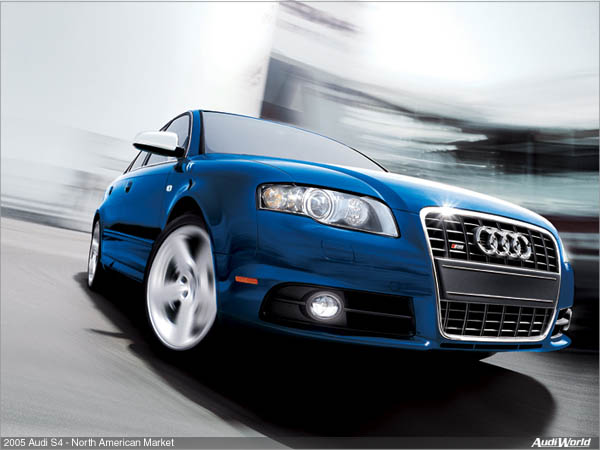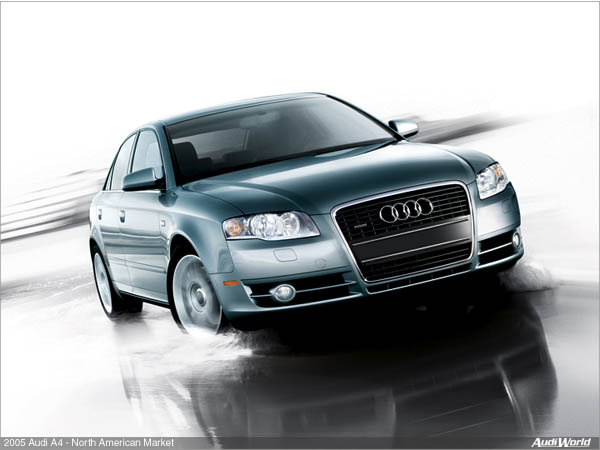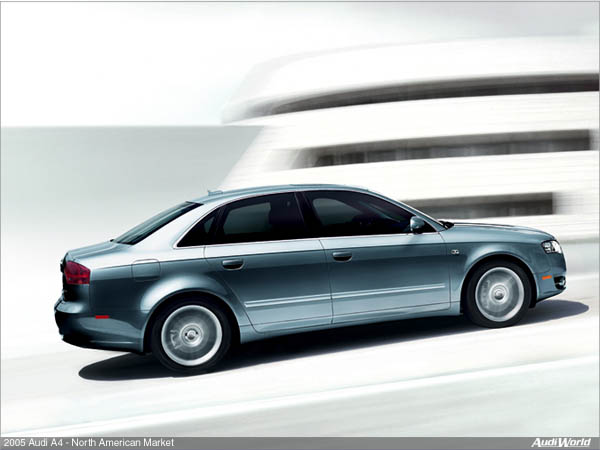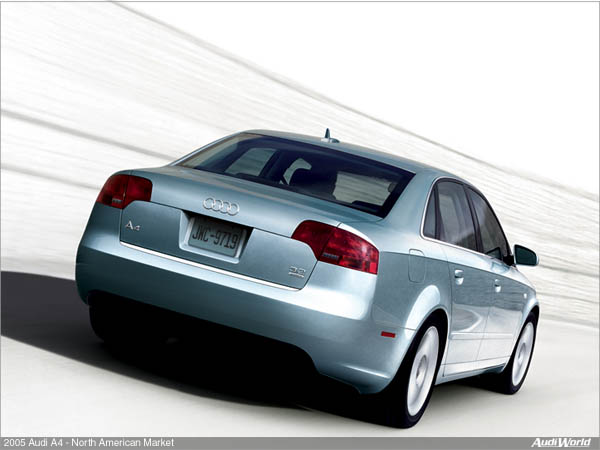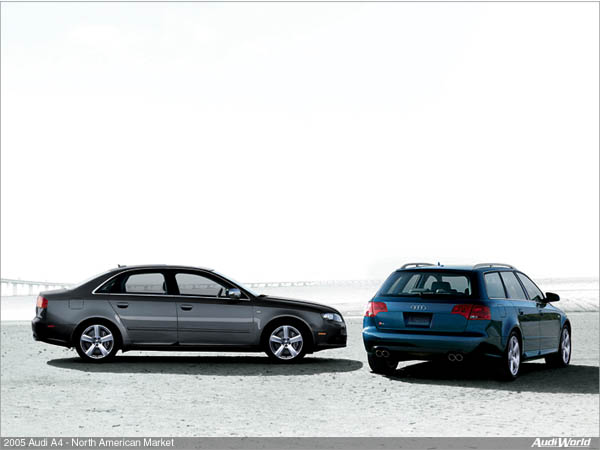Best Selling Audi Sedan – the Audi A4 – Redesigned in 2005
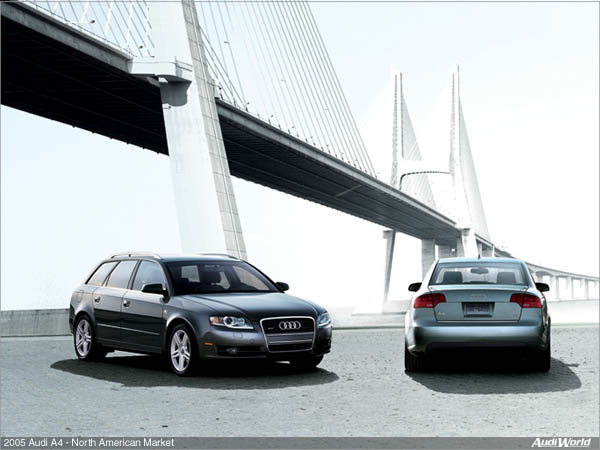
AUBURN HILLS, Mich. – Audi of America, Inc. is presenting the new generation of its best-selling models – the A4 and S4 sedan and Avant for the first time in North America at the Los Angeles and Detroit auto shows. The new A4 represents a higher dynamic level of driving pleasure, superior technology, exciting styling and a level of luxury that even satisfies the demands made in the premium sports class. The 2005 A4 and its performance sibling, the S4, represent Audis new model generation in the premium midsize segment that is obvious at first glance. The front-end styling of both sedan and Avant models is new, with the addition of the characteristic Audi single-frame grille. The rear end, with its emphatically horizontal lines, and the sides, where the shoulder line accentuates the panels in an emphatically sporty manner, are new. The vehicles’ technology lives up to the promise made by its new exterior styling. Innovative and highly sophisticated technologies are an integral part of practically all vehicle areas and components: the optional xenon plus headlights with pivoting dynamic adaptive light technology, continuously variable multitronic® transmission, quattro® allwheel drive and the revolutionary FSI (Fuel Straight Injection) engine technology. The A4 sedan and Avant will arrive at Audi dealerships in early April in both the United States and Canada. The S4 will be available around the same time.
Drivetrain Two performance-oriented engines are available in the new A4 sedan and Avant. The 3.2 V6 FSI, which made its production debut in the new Audi A6 in November, has all the features of an ultramodern engine: FSI gasoline direct injection with demandcontrolled fuel supply, a variable intake manifold and continuous camshaft adjustment on both the intake and the exhaust side. This V6 engine delivers 255 horsepower at 6,500 revolutions per minute. Its peak torque of 243 lbs. ft. is available at 3,250 rpm. More than 90 percent of the engine’s peak torque is available in the wide range between 1,900 and 5,900 rpm – a unique characteristic for a naturally aspirated V6. The A4 3.2 FSI is available with a six-speed automatic transmission with Tiptronic ® and quattro all-wheel drive, and the sedan accelerates from 0 to 60 mph in 6.6 seconds (Avant is 6.8 seconds) and on up to a governed top speed of 130 mph. FSI engines develop more power than conventional units with indirect fuel injection – and they do so with a very high standard of fuel economy. With the increase in efficiency achieved here, Audi has opened up a new dimension in the efficiency of FSI direct gas injection has confirmed its unique potential several times over in what must be the most challenging endurance test in the world: an engine with FSI direct injection powers the Le Mans-winning Audi R8. How does the FSI technology differ operationally from a conventional engine? The term “fuel direct injection” makes the central feature clear: in contrast to indirect injection, the fuel is injected directly into the combustion chamber. A common rail high-pressure injection system with a newly developed singlepiston high-pressure pump operating on demand ensures exactly the right supply of fuel, delivering precisely the volume required for building up operating pressure between 30 and 110 bar. In the intake tract, also comprising the two-stage variable intake manifold, moving charge-movement flaps provide the necessary tumble effect, swirling the induced air around depending on operating point. In order to achieve the high specific power and torque values, a new combustion process has been developed. Together with the optimum geometry of the combustion chambers and the dosage of fuel injected with supreme accuracy down to the last millisecond, this allows a significant increase in compression.
The 2.0 T FSI, an entirely newly developed engine, also is making its first appearance in the new Audi A4 sedan and Avant. This is the first time that turbocharging has been combined with the FSI concept of petrol direct injection. The 2.0 T produces 200 hp from 5,100 to 6,000 rpm. The maximum torque of 207 lbs. ft. is available from just 1,800 all the way up to 5,000 rpm. This exceptionally broad torque plateau on the one hand permits a fuel-efficient driving style with few gearshifts, and on the other hand means that only light accelerator action is needed to produce assertive thrust and a spontaneous unleashing of power. Several transmissions are combined with the new A4 2.0 T FSI. In the A4 sedan there are two front-wheel drive options: six-speed manual and a continuously variable multitronic transmission; and two quattro versions with either a six-speed manual gearbox or automatic transmission with Tiptronic. The A4 2.0 T Avant is available in only quattro all-wheel drive and the six-speed manual or six-speed automatic with Tiptronic. In the 2.0 T FSI the fuel is injected via a common rail system supplied by a demand-controlled high-pressure pump. The fuel is injected directly into the combustion chamber via an injector positioned at one side between the inlet valves. The four-valve cylinder head with low-friction roller cam follower drive has a modified inlet duct geometry that produces even higher tumble values than the naturallyaspirated FSI engine. This results not only in greater refinement, but also in superior knock resistance and therefore efficiency. Both the 3.2 and 2.0 T engines are longitudinally installed and qualify with the ULEV emissions standard, regardless of transmission version. The 2005 S4’s 4.2 V8 engine produces 340 hp at 7,000 rpm and a mighty peak torque of 302 lbs. ft. at 3,500 rpm. In acceleration tests, the S4 sedan rips from 0-60 miles per hour in just 5.3 seconds with a six-speed manual transmission and a specially tuned exhaust that announces the evidence of its power.
Audi Design Unmistakeably Audi: the new generation of the A4/S4 sedan and Avant once again exhibit the brand’s typical design features. Their sports character is immediately visible at first glance. The ratio of the large, clearly shaped body surfaces to the flat, equally bold strip formed by the windows is significant. The discreetly rising shoulder line accentuates a powerful, dynamic stature, even when the car is stationary. Clear proportions, the gentle curve of the roof, the striking, visibly flared wheel arches: even its silhouette The new A4 and S4 have grown slightly compared with its predecessor: the sedan is 38 millimeters longer, the Avant 41mm. The front end with its more substantial single-frame grille and new bumpers accounts for 12 mm of this additional length, the rear end for 28 or 31mm. The new design elements, however, are even more eye-catching, especially at the front end: the striking single-frame grille and the newly styled clear-glass headlights with their sweeping bottom edge and inward taper give the new Audi A4 and S4 a completely new face. The bumpers, which are fully painted in the body color at both front and rear, are also a new design. Thanks to their greater bulge and the fact that they reach a long way down, they accentuate the new model’s low center of gravity, seemingly bringing the car closer to the road. The front-end styling deliberately echoes design elements of the Audi Nuvolari quattro concept car, thus emphasizing that this model also belongs to the same family as the other new Audi models – the A8 6.0 quattro, A6 and A3: a new Audi generation. A clearly crafted horizontal light-refracting edge gives the bumpers additional shape. No less eye-catching at the rear end are the exhaust tailpipes which are now slightly larger from the previous generation – a clear indication of just what the new A4 models’ engines are capable of. All S4 models have sporty accents that hint at their power and performance. Vibrant exterior colors with contrasting titanium-colored inner housings, and distinctive S4 exterior mirror housings add a sporting look. S4 nomenclature on the trunk lid, a trunk-mounted rear spoiler (sedan) and aluminum roof rails on the S4 Avant, new dual exhaust pipes add finishing touches to the exterior of the S4.
The Interior The perfect tailor-made suit: a metaphor frequently used to describe vehicle interiors. But this image will come to the mind of anyone getting behind the characteristic wheel of the new Audi A4, with its hallmark feature of the single-frame element at the center. This, after all, is a car that unites two apparent opposites to produce an amazing synthesis of exceptional ergonomics and subjective comfort. On the other hand, the new A4’s cockpit is characterized by lines extending a long way into the door trim and center console areas, which quite literally appear to embrace the driver. This “wrap around” effect, to use the designers’ technical term, is accentuated additionally by the A4’s high waistline. This feature is something that many customers value very highly, not least because of the remarkable sense of security that it imparts. The architecture of the dashboard and center console also provide scope for positioning a wide range of instruments and controls high up, in other words ideally within the driver’s field of vision. This is an ergonomic strategy that is adopted in every aircraft cockpit for very good reasons. The lines of the driving area create a lively interplay of distinctly rounded, tangible shapes and graphically clear edges and notches. This area is thus divided up into clearly defined zones. These can be distinguished at a glance – a worthwhile ergonomic bonus that speeds up intuitive access to the individual information units and function groups. This process of locating involves both the visual and tactile senses: groups of controls and displays can also be identified by the materials used. The most important controls for the occupants’ well-being are located in the center console: dual automatic climate control, audio system, and the optional navigation system plus. Available only in the United States and Canada is a specially designed center console with dual cupholders with size adjustable tabs and an extra 12-volt power outlet. There is more room than average for luggage in the A4 sedan with a capacity of 13.4 cu. ft. The smooth-floored luggage compartment is well-equipped for tackling challenging transport tasks. And with a large distance between the wheel arches, there is plenty of room even for bulky loads. The A4/S4 Avant’s load area combines an exclusive atmosphere with optimum utility and variability. This synthesis of successful interior design and multifunction sets new standards. By design, the A4/S4 Avant’s load area offers a full range of ingenious details such as a net for small items, chrome-plated load-securing lugs, a storage compartment behind a cover in the left side panel, an easily accessible 12V power socket in the side panel and an active light in the tailgate that also illuminates the area behind the vehicle.
The body The body of the new Audi A4 is based on a unitary steel structure with integrated aluminium components. The percentage by weight accounted for by plastics and the use of the lightweight materials aluminium and magnesium is considerable. A further decisive measure with a low vehicle weight in mind is the expansive use of high-strength and very high-strength sheet-metal panels, which make up a total of 45 percent of the bodyshell weight. These special sheet panels are used primarily in the front end of the new A4, where the main priority is to absorb impact energy as effectively as possible in a frontal crash. As a protective cage, the occupant cell must also make sure that deformations and intrusions are minimized in a crash. Part of this task is performed by three large tailored blanks incorporated into the floor area. The wall thickness of each of these blanks varies. They are joined together by laser weld seams. Pages: [1] [2] |

